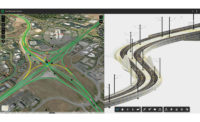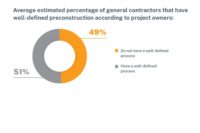For decades, the professional football and baseball teams in San Diego, Calif., played inside a brutalist bowl of concrete sitting in a sea of 18,870 paved parking spaces. When it came time to demolish the former Jack Murphy Stadium and build a new one on the same 166-acre site, that same concrete became the foundation for San Diego State University football’s home.
It’s the kind of reuse—part of a circular construction economy—that will become less an exception and more the rule globally as a greater number of lawmakers and regulators establish best practices for industry sustainability. It requires precisely measuring one’s materials. Contractors with an eye on this trend are already recovering, reusing, and recycling what they encounter in demolition as they build anew. By using location intelligence technology to make these operations more precise, they’re saving time and costs, and wasting less.
In the United States, an estimated 600 million tons of construction and demolition debris was produced in 2018, more than twice than what’s collected from residential curbs annually, according to the Environmental Protection Agency. Of that, 143.8 million tons was bound for landfills. In the European Union, where more than a third of all waste comes from construction and demolition, protocols and best practices have been established for how to handle construction waste with the goal that at least 70% (by weight) avoids landfills. “Responsible consumption and production,” is also number 12 of 17 in the UN’s Sustainable Development Goals (SDGs).
Cement production has been maligned for producing up to 8% of global human-made carbon dioxide emissions, according to London-based Chatham House. A top 25 commercial builder and developer in the U.S. has been relying more on sustainable materials and practices, including using less concrete. It’s opted for low-carbon cement when it can do so.
Keeping construction debris out of landfills is easier said than done, especially when faced with materials of unknown age, origin, warranty, or value. Construction officials documenting materials for a new build, sometimes referred to as a materials bank or passport, can lean on location technology to map everything in a digital record. That way, when a building reaches the end of its lifecycle and nears demolition, the owner will have an exact inventory and location of each asset. This includes knowing where, for example, a light fixture came from, allowing for it to be returned to the manufacturer and warrantied again for reuse.
It's where construction and data management align. Some of the smartest design-build customers are even adding data ownership to contractual obligations. They are digitizing this data using geographic information system (GIS) technology which enables location awareness and spatial analysis. By going beyond a binder of printed pages handed off at project completion, it ensures the end user will have every detail about every asset inside their building.
Attaching a Value to Waste
There’s less incentive to embrace a circular mindset if the materials themselves aren’t considered valuable. Absent a marketplace, two factors could help add value to the act of documenting a project’s pieces and parts: contractual obligations and regulatory requirements.
That’s what has happened in Vancouver, British Columbia, Canada as PCL Construction is building the $1.7-billion, 2-million-sq-ft St. Paul’s Hospital for Providence Health Care. Providence has intended for St. Paul’s Hospital to be a sustainable, 100-year facility. The health care company contractually requested all BIM data related to construction be digitally delivered. That way, the data can be used beyond the project’s closeout and for asset management during the building’s lifetime.
Providence’s request specified the assets and equipment attributes needed to operate the hospital. PCL started with a naming standard that created unique asset tags in their models, then used the tags to provide information from its submittal log and data from the commissioning process. The process also helped to link PCL’s design and construction models together to provide accurate asset locations. Using GIS technology, the company will be collecting the data as it builds so it will live on long after construction is done.
Volume Measurements via Drone
In San Diego, as the former Qualcomm Stadium was being demolished, large stockpiles of concrete were processed at an on-site batching plant to be used on the new stadium construction, including access roads. To estimate the material size on site at a given time, the construction manager for San Diego State University, OCMI Inc., used Site Scan for ArcGIS, cloud-based drone mapping software designed for imagery data collection, processing, and analysis. The GIS solution allowed construction teams to run volume calculations with drone-captured imagery. When a grading subcontractor requested a change order claiming there wasn’t enough material to build the base of the stadium, the information from Site Scan proved otherwise.
In the United Kingdom, a joint venture between Balfour Beatty and VINCI on the HS2 high-speed rail project also used drones to survey aggregate piles. They saved about 20,000 lbs annually using drones on their monthly construction progress surveys that take 3D volumetric measurements—cutting the process from a full day to 20 minutes.
Back in Vancouver, PCL Construction used the same drone scanning technology to estimate the volume of a boulder the size of a large pickup truck that was unearthed during excavation for the new hospital. The aerial volumetric measurements monitored other boulder piles at the project site, too, as more material was found.
When it came time for the subcontractor to remove the boulders, the measurements helped reduce the initial quoted cost by 40%. It saved PCL money but also its relationship with the subcontractor since it otherwise could have turned into a dispute settlement.
Drone imagery helped the company precisely pre-plan where it would position trucks and pumps for the project’s cement foundation placement. That element would ultimately involve a little more than 500 ready-mix trucks parading into and out of the construction site for 12 hours. The coordinates were given to the surveying crew that labeled the locations on site. As Bilal Yasir, PCL’s integrated construction technology specialist told a crowd gathered for Esri’s User Conference in San Diego last summer, “everything fit like a jigsaw puzzle with precision and accuracy. There was no hassle, no frustration, and no on-site coordination on the day of pour.”
Calls for sustainability can sometimes feel amorphous, out of reach, and nice in theory. In construction, efficient reuse and limiting materials waste in the real-world is accomplished through accuracy and precision, whether in locating assets and materials or measuring their volume. Technology like drones and GIS provide information that makes that precision possible to help contractors reach a new level of sustainability – both in keeping waste out of landfills and saving money.
Kathleen Kewley is director for AEC global business development at Esri, leading a team that supports architecture, engineering and construction's digital transformation by leveraging GIS to unlock the business value of digital twins of the natural and built environments. Prior to joining Esri, Kewley spent 10 years at Autodesk in key business development roles, helping architects, engineers and construction professionals transition to 3D geospatial and building information modeling.





Post a comment to this article
Report Abusive Comment